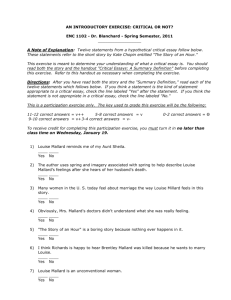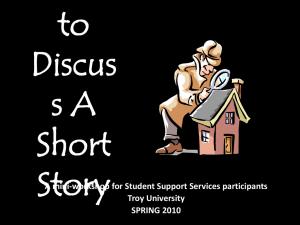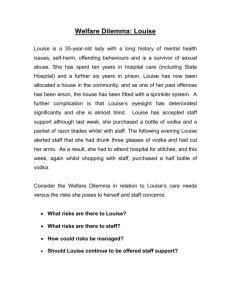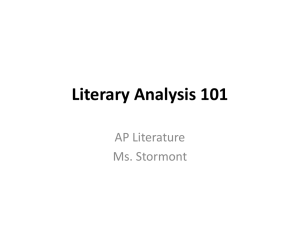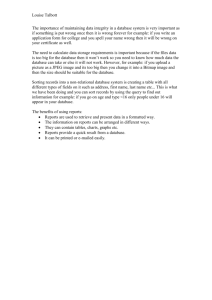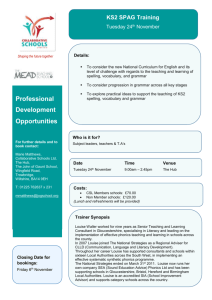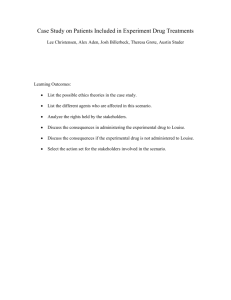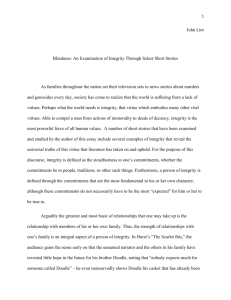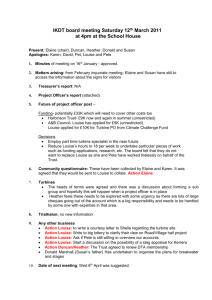ENL 121 - KISS Grammar
advertisement
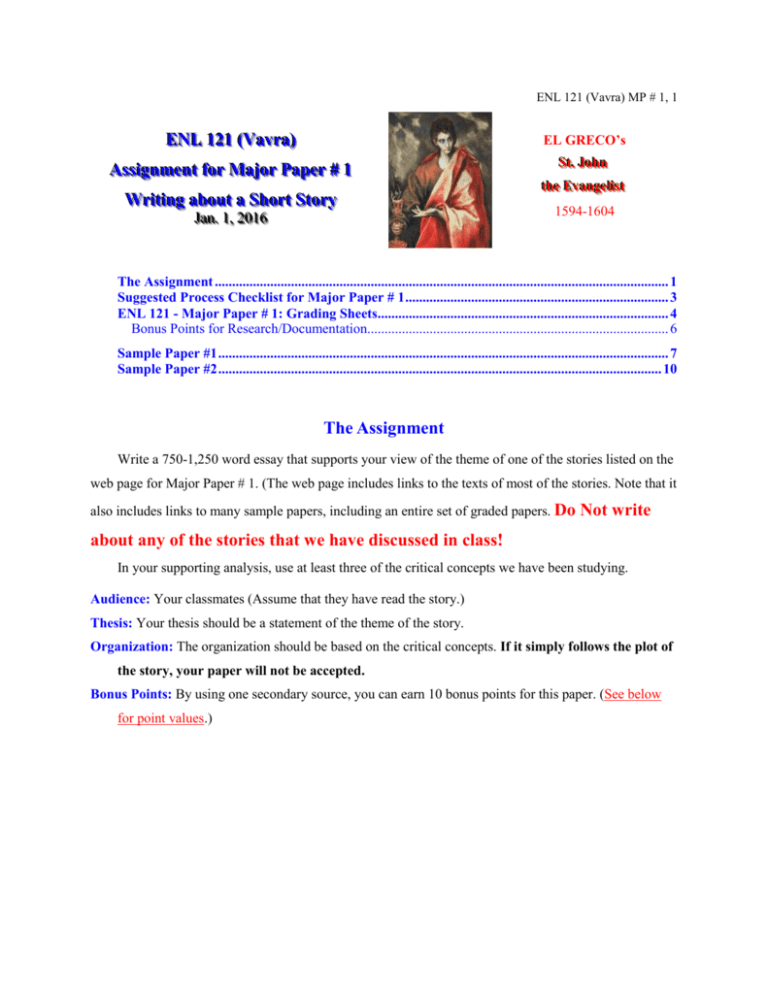
ENL 121 (Vavra) MP # 1, 1 E EN NL L 112211 ((V Vaavvrraa)) EL GRECO’s A Assssiiggnnm meenntt ffoorr M Maajjoorr PPaappeerr ## 11 SStt.. JJoohhnn W Wrriittiinngg aabboouutt aa SShhoorrtt SSttoorryy JJaann.. 11,, 22001166 tthhee EEvvaannggeelliisstt 1594-1604 The Assignment ................................................................................................................................... 1 Suggested Process Checklist for Major Paper # 1 ............................................................................ 3 ENL 121 - Major Paper # 1: Grading Sheets.................................................................................... 4 Bonus Points for Research/Documentation....................................................................................... 6 Sample Paper #1 .................................................................................................................................. 7 Sample Paper #2 ................................................................................................................................ 10 The Assignment Write a 750-1,250 word essay that supports your view of the theme of one of the stories listed on the web page for Major Paper # 1. (The web page includes links to the texts of most of the stories. Note that it also includes links to many sample papers, including an entire set of graded papers. Do Not write about any of the stories that we have discussed in class! In your supporting analysis, use at least three of the critical concepts we have been studying. Audience: Your classmates (Assume that they have read the story.) Thesis: Your thesis should be a statement of the theme of the story. Organization: The organization should be based on the critical concepts. If it simply follows the plot of the story, your paper will not be accepted. Bonus Points: By using one secondary source, you can earn 10 bonus points for this paper. (See below for point values.) ENL 121 (Vavra) MP # 1, 2 A suggestion for introductions and Conclusions—For this paper, build them from your theme. The following, for example, could be an introduction and conclusion for a paper about Kate Chopin’s “The Story of an Hour.” Can men and women ever understand each other? A popular book claims that women are from Venus and men are from Mars. Fine, men and women are from two different planets, but we are living on this one, and, apparently, we need each other. So what can we do about it? Understanding, of course, is important, but women are not always very helpful. In “The Story of an Hour,” for example, Kate Chopin inexplicably suggests that women are terribly imprisoned by men. [Body of the paper] It was very nice of Ms. Chopin to show us that some women are very frustrated in their marriages. Unfortunately, she did not show enough of either Mr. or Mrs. Mallard for the reader to get any sense of their relationship. What, after all, does Mrs. Mallard want? Does she try to talk to her husband and he ignores her? It’s true that some men do not pay attention to their wife’s feelings, but should men feel guilty about their marriages just because Mrs. Mallard wants some undefined, vague “freedom”? Note that this is a suggestion for a decent introduction and conclusion. A better job will reflect your ability to show your classmates why what you have to say about the story should interest (or be important to) them. ENL 121 (Vavra) MP # 1, 3 Suggested Process Checklist for Major Paper # 1 _____ 1.) Read all the stories. (The last one you read may give you the highest grade.) _____ 2.) Research for a secondary source. _____ 3.) Brainstorm, on paper. When you have found a story that you think you might like to write about, take two or three pieces of paper. At the top of one, write “Conflicts.” About a third of the way down the page, write “Setting.” Two thirds of the way down, write “Symbols.” Do the same on the back of the sheet, but write “Characterization,” “Plot,” Point-of-View (Narrator).” On another sheet, write “Irony” and “Tone.” Based on what you have learned about these concepts in class, go back and make notes about each concept as it relates to your story -- for example, what “conflicts” are in your chosen story? Fill in as much as you can for each of the concepts. Then study your notes, and find the three that you can best use to support a statement of the theme of the work. _____ 4.) On paper, make a tentative thesis and outline. [If you want better than a C for a grade, don’t forget that you need subdivisions in one of the major sections of your paper.] _____ 5.) Write a draft of the paper. _____ 6.) Revise the draft at least once. (Suggestion: Use the grading sheets, and grade your paper for Audience, Thesis, Organization, and Details as you revise.) _____ 7.) Use the MLA format for your paper. _____ 8.) Edit the draft (and grade your paper for Style). _____ 9.) If you have not already done so, make a paragraph outline. ____10.) Make an electronic copy of the paper and outline. Put all of these in one file, with the outline after the paper. Save it to a file with a name based on your last name, first initial, and the paper number. (For example, VavraEMP1.doc). Submit the electronic copy in the Plato dropbox for MP1. _____ 11.) In your envelope, put the final copy on top, next the final grading sheets, then the draft that you graded in class and the grading sheets for it, followed by other drafts, storming, copies of sources, and everything else you wrote in doing the paper. (Mark the final copy “Final” so that it is identifiable.) ENL 121 (Vavra) MP # 1, 4 Student’s Name:_____________________________________ ENL 121 - Major Paper # 1: Grading Sheets These grading sheets are optional. If you complete the “Student’s Grading” for each item, I’ll complete the “Instructor’s Grading.” Otherwise, I just give you comments and your final grade for the paper. Remember that I will not grade your paper until I receive both the envelope with the final printed copy, all your drafts and notes, and copies of your sources—and an electronic copy of your paper. (If the paper copy is not in on the due-date, your paper will be considered late.) Format and Process (20) ATODS (Total) (80) Basic MLA Format (5) Basic Grade Outline (3) …..Paragraph Outline (2) Evidence of Revision (5) Correct electronic copy (2) Everything in an envelope (3) Bonus for Research (10) Style Point Penalties Late Penalty Final Grade for Paper Audience (10 points) Possible Student's Instructor's Points Grading Grading 0–2 0–2 0–4 0–2 Description The title of the essay reflects thought (metacommentary). The introductory paragraph is—average (1); above average (2) Introduction includes the author and title of the work written about The concluding paragraph is—average (1); above average (2) Thesis (15 points) Fill in the blanks with the concept you are grading. Possible Student's Instructor's Points Grading Grading 0–3 0–3 0–3 0–3 0–3 Description The thesis is thoughtful and clearly identifiable. The thesis is a supportable statement of a theme. The first concept (_________________) supports the thesis. The second concept (_________________) supports the thesis. The third concept (_________________) supports the thesis. ENL 121 (Vavra) MP # 1, 5 Student's Name:_____________________________________ Detailed Grading Sheet (2 of 2) for MP #1 Organization (20 points) Possible Student's Instructor's Points Grading Grading 0–3 0–3 0–3 0–3 0–3 0–3 0–1 0–1 Description The formal outline is well organized to support the thesis. Topic sentences embody the outline. Focal/Topic sentences relate paragraphs to the thesis. Topic sentences cover paragraphs. Paragraphs are not too long or too short. Focal Sentence - Sub-divisions of a major section of the outline (Roman number) are spread over more than one paragraph.. First Topic Sentence of Sub-division A Second Topic Sentence of Sub-division Details (23 points) Fill in the blanks with the concept you are grading. Possible Student's Instructor's Description Points Grading Grading The essay includes at least two short quotations (words or phrases) 0–4 from the story. 0–4 The quotations (above) are important support for the essay. 0–5 One concept (______________) is explained in good detail. 0–5 A second concept (______________) is explained in good detail. 0–5 A third concept (______________) is explained in good detail. Style (12 points) For the Style Penalty Points, see “Style Penalty Points” in the “Guide to Punctuation and Usage” on the course website. Possible Student's Instructor's Description Points Grading Grading 0–4 Punctuation marks, including underlining, are used correctly. 0–2 First and second person pronouns are not used. 0–3 Transitional words and phrases are well used. 0–3 There are few or no sloppy errors. ENL 121 (Vavra) MP # 1, 6 B Boonnuuss PPooiinnttss ffoorr R Reesseeaarrcchh//D Dooccuum meennttaattiioonn A secondary source is an article in a book, journal, or a database (including Google Scholar), or from a web page. Other sources from the web will not be considered credible unless you can establish their credibility. (Abstracts and regular dictionaries do not count as sources.) Note: Document sources by using the new MLA format. Failure to include a labeled print-out of the secondary source in the envelope will result in no credit for it. Similarly, you will receive no credit if the source is not on the Works Cited, or if it is not cited in your paper. Highlight or underline the material that you quote or paraphrase. If I cannot find the material you cite in the copy of the source material, you will not get credit for using it. Source # Points 1 2 Author/Title of Source Voice Marker 1 Credibility Marker 1 In-text Citation 1 Metacommentary 1 Correct Works Cited 1 From a database * 2 Substantial 3 Inaccurate ** Total Points = * For some of the authors, you will have trouble finding substantive sources about the story. But for this case, you can go to the Literature Resource Center database and find a biographical or other article that you can use for this credit. ** Inaccurate—An inaccurate quotation (or a paraphrase that is actually a quotation) will result in no points for that source. (Note that this assumes that you have cited the source. If you have not, then it is a case of plagiarism.) ENL 121 (Vavra) MP # 1, 7 Sample Paper #1 Jane Doe Dr. Vavra ENL 121, Sec xx September 23, 2004 A Joyous Death 1. In “The Story of an Hour,” Kate Chopin suggests that in certain situations, the death of a loved one may be a blessing. Such situations may include an abusive relationship, or an unhappy marriage, as this story suggests. In Chopin’s story although the circumstances might lead the reader to believe that Louise’s husband’s death would cause her great pain, ironically, when she hears the news, she feels a great sense of relief. This suggests that death may not always cause grief. 2. Louise’s characteristics add to the theme of this story in several ways. One of her characteristics is her youth. This characteristic is important because it is symbolic of a fresh, new start at her life of freedom due to the death of her husband. She has her whole life to live by herself. She will be free to do what she wants to do, when she wants to do it. 3. Another characteristic of Louise, which also adds to the irony of this story, is her passion for living. She mentions that she will weep again when she is present at her husband’s funeral, but she is able to look past that grim moment and look forward to “the years to come that would belong to her absolutely.” Just when she is beginning to savor the sweet sense of freedom, her husband shows up at their house alive. When she sees him, she dies, not from the “joy that kills,” but because she is heartbroken and shocked at the reality. She dies because she realizes that since he’s not dead, she will not be free. The drastic halt is too much for her to handle. 4. There are a few symbols in the story, which are symbolic of Louise’s life of freedom. The spring day symbolizes a new beginning of her life in which she is free. Spring is the time when living things propagate and are reborn. Likewise, Louise believes she will become productive, energized and reborn. Louise has her whole life of freedom to look forward to. 5. A second symbol is the open window in her bedroom. The window suggests that there is no material object standing in the way of her new life. There is a clear passage between her life of captivity to her life of freedom. Her husband was the only person holding her back, but now that he’s gone, she’s able to look forward to the future when she can live her life for herself. 6. The most important conflict in this story is appearance versus reality. To all people it would appear that Louise would grieve over Brently since they would assume she was happily married and content in her sub-serviant role as a housewife. Louise’s sister Josephine exemplifies such a judgment of ENL 121 (Vavra) MP # 1, 8 how Louise’s reaction to the sudden death of her husband Brently. Josephine misinterprets Louise’s behavior, thinking she is hysterical over Brently’s death. She pleads, “Louise, open the door! I beg; open the door-you will make yourself ill.” To Josephine, Louise appears to be heart-broken, but in reality, Louise is relieved by his death. 7. Louise’s friend Richard also has mistaken notions of how Louise will react. He rushes over to tell her of the “sad” news, when unknowingly to him, it is very good new to Louise. An ironic aspect about this story is the fact that Richard rushes over to tell Louise of the news of her husband’s death and is too late to block Brently’s view of his wife. If he was too late getting the news to Louise, Brently would have made it to the house first, and Louise would have lived her life as she did previously. Richard was, in a way, responsible for Louise’s death. 8. The doctor’s judgment of how Louise dies also deals with the appearance versus reality conflict. For example, the doctor predicts that Louise died from the “joy that kills,” believing she was so overcome by the joy of seeing her husband alive, she is physically incapable of dealing with such a strong emotion of joy. But she actually dies because her free life has come to a sudden stop. And is heart-broken that she will not be able to live her life as she hoped she could, alone. 9. Another conflict in this story is the role of the wife versus the role of the husband. For instance, Louise struggled with her feelings about her marriage for years. Louise thinks “what could love, the unsolved mystery, count for in face of this possession of self-assertion which she suddenly recognized as the strongest impulse of her being.” She admits that she did love Brently, but often she did not. On the other hand, the story suggests that Brently was completely content in the marriage and assumed that Louise was too. This conflict is reflected in Louise’s internal struggle. When she realizes that Brently is alive, she must die. This is the only way she can win the freedom she was struggling for within herself. She dies because he is alive, he is ultimately responsible for her death. 10. Kate Chopin’s goal or the theme of this story is to suggest that women are expected to maintain the role that society implies on them. Men are made out to be superior and women are to do what they say and are to serve them. In this story, this fact is what causes Louise to feel the way she does about Brently’s death. She is tired of being stuck doing whatever he expects her to do. She looks forward to being independent and free. Although death is supposed to be a sad time, not all situations would support that. For example, if a person has been suffering for quite some time, it would be a blessing that he or she died. At least this way, you know that he or she is not suffering anymore. ENL 121 (Vavra) MP # 1, 9 Outline 1. 2. 3. 4. 5. 6. 7. 8. 9. 10. I. Intro & Thesis: Death does not always lead to grief. II. Characterization A. Young: Her youngness is also symbolic of a fresh, new start at her new life of freedom. B. Passion for living: She looks forward to her many years of not being tied down. III. Symbols A. Spring day: a new beginning of her life in which she is free. B. Open Window: her accessibility to her new life of being free. There is nothing standing in her way. IV. Conflicts A. appearance/reality 1. Josephine's thoughts of how Louise is reacting (pg13) "Louise, open the door! I beg , open the door -- you will make yourself ill." 2. Richard's own thoughts of how Louise will react. He rushes over to tell her of the "sad" news when unknowingly to him, it is very good news to Louise. 3. Doctor's judgment that she died from "joy that kills," supposedly about her husband's life but she actually died from her free life coming to a sudden stop. B. role of wife / role of husband 1. Louise's struggle with her feeling about her marriage for years. 2. Brently was content in the marriage and assumed Louise was too. V. Conclusion ENL 121 (Vavra) MP # 1, 10 Sample Paper #2 Dan Smith Dr. Vavra ENL 121, Sec xx September 23, 2004 With Life Comes Problems 1. In today’s world there is nobody who can honestly say that they have absolutely no problems or worries in their life. Everyone has something to deal with and things to get over in their life--that’s why it’s called life. As long as you’re alive, you will constantly have to battle the burdens of life that all people encounter. Some are destroyed by the hardships and others overcome them. In Kate Chopin’s “The Story of an Hour” she gives a glimpse at the life of one woman who, for a brief time, felt she would have no more problems, but then is shocked in to death by realizing that her problems were not yet gone. The theme of the story is that you are never really free from the troubles of life until you are dead. 2. The conflicts in the story are ones that we all encounter and deal with until the day we die. In the story there is conflict between Louise (woman) and her husband (man). It said that sometimes she loved her husband, but often she did not. This says to me that they did not have a good relationship together, and were probably constantly battling. Another conflict would be Mrs. Mallard’s life vs. Mr. Mallard’s death. Because of Mr. Mallard’s suppossed death, Louise would now live her life happier and for herself. Then, when Mr. Mallard came home, Louise was faced with the conflict of choosing between the freedom she would have had or the repression she would now suffer, from her husband, for the rest of her life if she would stay alive. At the end she, in a way, chooses death over repression. The only true way for her to be free was to die. 3. The symbols in “The Story of an Hour” give a look at the good life and rebirth Louise would have had if Mr. Mallard would have actually been dead. The actual word mallard refer to a wild duck. The meaning of duck, other than the animal, is to avoid a blow. Mrs. Mallard was constantly ducking wildly from her husband’s blows, whether mental or physical. The calm after her storm of grief was her realizing she was better off without her husband after her going through the initial shock of the whole ordeal. In paragraph five it refers to “the new spring life” and the rain that was in the air, signifying Louise’s rebirth and growing now that Mr. Mallard was gone. “The notes of a distant song which someone was singing reached her faintly” represents good times and freedom that she used to know slowly coming back. The sparrows were twittering outside her window. Twittering means to carry on excitedly, which is what Louise was actually doing inside now that she was able to be free. At the end, the ENL 121 (Vavra) MP # 1, 11 latchkey that Mr. Mallard uses to get in the front door symbolizes his neglect of her, and how it would still be if they continued together. 4. This story is very ironic in that everything that happens isn’t the reality of the situation. Mrs. Mallard is crying after she finds out her husband is dead is ironic because she is actuallt releived and sort of happy. Now that Mr. Mallard was gone she hope that she would live a long life, which is obviouslly iron because she then dies (perhaps choosing to die) when she finds out he is not dead. The last sentence of the story says that she died “of joy that kills.” In reality she died of sadness that kills--the sadness she saw that she would have endured had she lived the rest of her life with Mr. Mallard. 5. With the problems of life come decisions. Deciding what is best or what has to be done in a situation is sometimes hard. In “The Story of an Hour” Louise sees that with her life comes problems. She is left with the decision of living with all her problems or dying and leaving them all behind. In our lives it usually isn’t that drastic, but it makes the point that you are always going to have hardships in your life. You just need to get over each one as it comes and move on with the things you want to do. You will never be free of cares until the day you die. The way you deal with the problems in your life will determine the quality of your life. (1) (2) (3) (4) (5) Outline I. Intro and thesis: The theme of Chopin's "The Story of an Hour" is that you are never really free from the troubles of life until you are dead. II. Conflicts A. Man vs. Woman B. Life vs. Death C. Freedom vs. Repression D. Repression vs. Death III. Symbols A. The name Mallard 1.it's a wild duck 2.duck (not the animal) means to avoid a blow B. The calm after Mrs. Mallard's storm of grief C. "...the new spring life." D. "...rain was in the air." E. "The notes of a distant song which someone was singing reached her faintly, and countless sparrows were twittering in the eaves. F. The latchkey IV. Irony A. Mrs. Mallard crying B. She hoped her life would be long C. They thought she died "of joy that kills" V. Conclusion: With life comes problems. Dying is the only true way to rid yourself of any and all cares and troubles.
